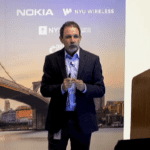How to best utilize high band spectrum, and the associated backhaul challenges that will accompany massive densification took center stage
As the final keynotes of the conference gave way to afternoon panels, the discussion became increasingly technical during the second full day of proceedings at the Brooklyn 5G Summit. Similar to day one, the morning proceedings featured a keynote from a major U.S. operator. In this case, Bill Stone, VP of Technology Development with Verizon, gave a talk that focused on the carrier’s spectrum holdings and associated network densification strategy. The theme of the day seemed to coalesce around how best to leverage high-band spectrum. From there, several panels delved into discussions related to spectrum availability and shared spectrum schemes, to the role that Integrated Access and Backhaul (IAB) can play in helping to solve backhaul challenges in ultra-dense environments.

Bill Stone of Verizon
Source: IEEE event live stream
High band spectrum presents many challenges
One key takeaway from the conference is that high-band spectrum was a top-of-mind topic. In the U.S., the Federal Communications Commission has already auctioned off high-band spectrum assets and is getting set to make additional licenses available in the 24, 28 and 37 GHz frequencies this coming November. This combined with the relatively low starting bids, compared to low-band spectrum auction prices, means that there should be plenty of opportunities for service providers to stake their claim to these frequencies that lend themselves quite well to mmWave transmission schemes. At the same time, noted propagation issues related to the inability of millimeter waves to penetrate common obstructions such as foliage, buildings and other common objects were also prevalent in the day’s discussion.
Backhaul schemes must not trade one scarcity for another
Hand-in-glove with an exponential rise in radio resources related to mmWave propagation is the need to backhaul the traffic. At present, operators with the best fiber assets are in the best position. Going forward, however, it is generally accepted that an “all hands on deck” approach to backhaul will be required. During the backhaul panel that took place during the afternoon session, IAB dominated the discussion as a way of better leveraging the high band spectrum that is being envisioned to enable the massively densification of networks.
As one panelist pointed out, however, a potential pitfall that needs to be considered is the potential for IAB schemes to represent little more than a trade-off between high cost fiber-based backhaul for high cost backhaul solutions that lead to inefficient spectrum utilization.
Final word: 5G deployments will be operator-specific
As the day’s proceedings wrapped up, the capstone analyst panel summarized things well by pointing out that the service provider keynotes provided a good microcosm of insight into how 5G roll-outs will be different from previous technology generations. Whereas previous 2G, 3G, 4G roll-outs focused on building out the broadest network fastest, 5G will be more pointed to address a mélange of business models that fit well with either their current infrastructure strengths, or the lifestyle preferences of their customer base.
The case in point citations included Verizon’s tack of going hard after 5G as a fixed wireless technology as a means of taking advantage of its pervasive fiber assets to enable robust fronthaul and backhaul to fixed wireless access points in support of residential and enterprise broadband services. Vis-à-vis this with a presentation from KT that showed that the Korean operator is focusing its 5G roll-outs in 3.5 GHz and 28 GHz spectrum bands to drive the proliferation of immersive consumer video experiences. Finally, compare this with AT&T’s strategy that is driven by its network virtualization strategy that will underpin the ability to offer a vast array of dynamic services in support of the carrier’s IIoT and vertical enterprise strategy.
If flexibility is supposed to be the hallmark of 5G, then ending the conference on a note of commercial roll-out ambiguity might be spot on.
The post Brooklyn 5G Summit: Spectrum and backhaul issues dominate day two appeared first on RCR Wireless News.
